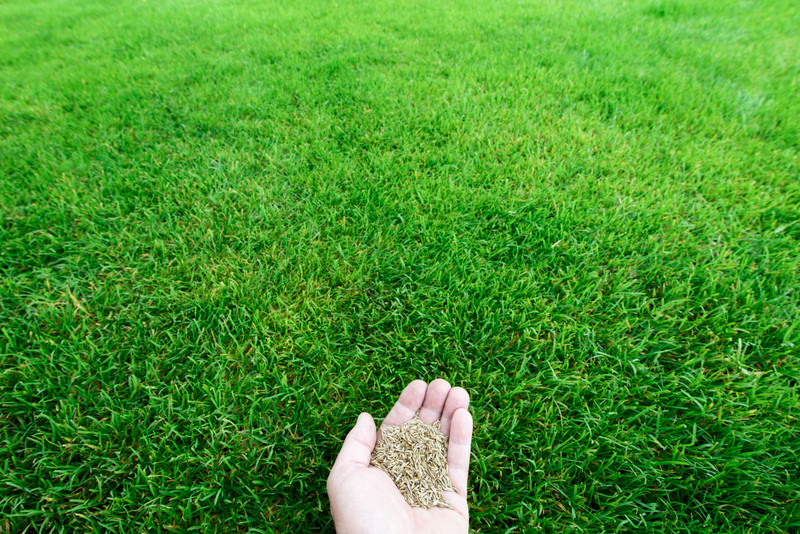Creating a New Lawn From Seed
Posted by Lisa Taylor on 19th May 2022
Although turfing an area is a great way to get an almost instant lawn, many people choose to use grass seed and grow it themselves from scratch. The most popular reason for choosing seed is that it is less expensive. Grass seed can be bought at any time of the year and stored until required, where-as turf has a short shelf life and should be laid as quickly as possible. (Ideally within 24 hours in summer time to promote optimum health.)
When to sow a new lawn
The best time to sow a new lawn is in mid spring or early autumn. Grass seeds like moderate conditions - not too hot or too cold. Ideally the soil should be warm and there should be plenty of moisture. Germination normally takes place between 7 and 10 days if the conditions are correct. Severe frosts or periods of extreme heat and dry weather will definitely affect the timescale for seedlings to sprout and establish.
Choosing a seed mixture
There are a number of different seed mixtures available on the market. This can be daunting - what mixture is correct for your garden? The key is to think about what you need from your lawn and how you plan to use it. Does it need to be durable to withstand children and pets playing on it, or are you looking for an ornamental lawn that won't be used that often?
A general purpose lawn with high levels of use should be a mix of hard wearing grasses. This includes perennial rye grass, tall fescues and sometimes brown top, all of which grow quickly and provide good strength and durability. Luxury and ornamental lawns tend to be made up of fine leaved grasses, including chewings and slender fescues. These fine grasses are good to look at but they will not tolerate high volumes of traffic or heavy wear and tear.
There are a lot of other grass seed blends available that promise something different (ideal for shady areas, quick growing, etc) however if you look at the specific seeds they will normally be a blend of the seeds mentioned above.
Point to note - it is possible to find a hard wearing grass seed blend that looks good too!
Preparing your seed bed
Whether laying turf or sowing grass seed the key to a successful lawn is in the preparation. With grass seeding particular attention should be paid to clearing any existing weeds and cultivating the surface to create a fine tilth (factors that determine tilth include the formation and stability of aggregated soil particles, moisture content of the soil, degree of aeration, rate of water infiltration, and drainage.)
To prepare the seed bed, all weeds should be removed. If using weed killer do not use a residual one as it stays in the soil and can prevent your seed from germinating.
Dig or rotovate the soil to a depth of around 15 - 20 cm. Mix in some well-rotted manure or compost to the soil. It is best to leave it to settle for a while. After leaving the seed bed new weeds may have started to grow so once again remove any weeds. (This will be a lot easier this time round!) Work the area by raking it in several different directions to level the soil out. Firm the soil, and then rake it again to leave a nice workable surface and rake in a general purpose fertiliser.
Sow your seed bed
Your grass seed supplier should supply you with the recommended application quantities. For our grass seed we recommend 50 g per m2 for a high quality ornamental turf and 25 g for a general purpose turf.
Split the seed quantity in half and sow over the whole area with half of the seeds, by working in parallel rows lengthways. Using the remaining seed, spread the seed over the whole area in parallel rows width-ways, effectively sowing a cross hatch pattern. If using a seed distributor the same method can be used, but calibrate the seed distributor.
Lightly rake over your seed bed, covering most of the seeds with the soil.
If the weather is dry for two or three days after sowing lightly water the area. You must continue to water as necessary during the germination stage (anything between 7 - 30 days normally) because the young seeds will die if they are left to dry. Watering grass seed can be tricky - too much water can displace the seeds resulting in an uneven coverage of grass. You also don't want to drown the seeds as this can hinder growth and even kill them.
Aftercare and tips
When the grass seedlings reach around 3 inches high the soil should be lightly compacted again, by either carefully treading or using a garden roller.
The first cut should take the grass down to 2 thirds of its length (removing one third). The mower blades should be sharp, and if the mower has a front roller this should be removed to avoid flattening the young grass swards.
New lawns should not be used extensively during the first season.
Don't forget - birds like to eat grass seed. You can either sow extra grass seed to account for any losses from birds, or alternatively you can use bird tape to deter them in the first place. Bird tape doesn't harm birds - it is often shiny and makes a humming noise as it vibrates in the wind.

